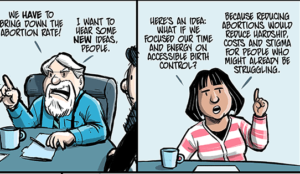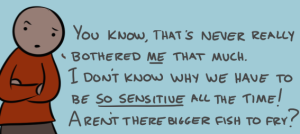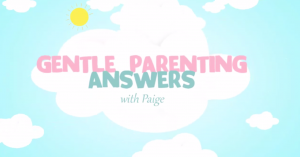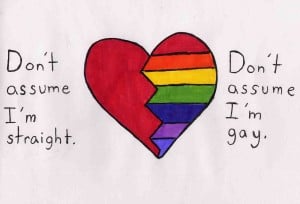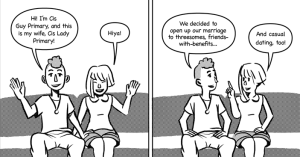Originally published on Tranifesto and cross-posted here with their permission.

Credit: Fickle Cattle
The decision to come out – and to whom – is as individual as you are.
Certainly, if you are going through a physical transition, including hormones and/or surgery, those people close to you are going to notice changes, and eventually, they will either catch on or become concerned about your physical health.
It is likely that you will have to come out to those people closest to you and those people you see frequently, like coworkers. However, being publicly out – as an activist or as anyone in the public eye – is a decision you must weigh.
Once you are out publicly – in the media and especially on the Internet – it will be very difficult, if not impossible, to go back into the closet, or to “live stealth,” again.
There is no rush to come out publicly, and many people never do. If you’re unsure, wait.
If you’re starting your transition, and you think you want to be out as an activist, as a blogger, on Facebook, or in any other capacity, it’s okay to give yourself some time.
You can always come out – but again, once you’re out, you can’t always go back in.
Only you know what’s right for you.
When Should I Come Out?
I can’t tell you when to come out, because each person’s situation is different, but I can give you some things to think about and to weigh against your own coming-out timetable. Here are my thoughts on coming out to:
1. Supervisors, staff, and coworkers
I think your supervisor should be told first and should be consulted about how he or she wants you to handle coming out to your own staff and coworkers. You’ll have an easier time at work if you make a cooperative plan with the higher-ups.
But with my own experience as a guide (I waited too long, and my coworkers and staff thought that I had cancer because I cut my hair and stopped wearing makeup), I suggest that you do it before making any major changes in your appearance.
Staff and coworkers are going to gossip enough – make sure they’re gossiping about the right thing.
2. Friends and family
Only you know your friends and family well enough to know an appropriate time frame for coming out to them. Again, however, I suggest that you do it before making any major changes in your appearance or before the hormones you’re taking, if you’re taking them, start to have a major effect.
The problem with hormones is that, while you know in general what they will do, you have no idea how they will interact with your specific genetic programming and physiology.
You can only fool your mom for so long by telling her you have a cold before that voice change will become too apparent to hide – especially if it’s accompanied by a beard that rivals Rip Van Winkle’s.
3. Potential partners
Again, this depends on your situation. And I don’t believe that you have to come out to every coffee date you have – in fact, I would advise against it, especially in a small community.
I personally come out if there’s any hint that the encounter will lead to intimacy – and personal safety is paramount.
So before you leave the bar, the coffee shop, or the party, consider coming out. You may go home alone, but at least you know you’ll get home.
It is best to come out in a public place, and you should always consider your safety options. If it appears that coming out might be unsafe in a particular situation, then don’t do it.
4. Strangers
I live my life completely out, but I don’t introduce myself as Matt Kailey, transsexual. It would make for interesting small talk, however.
There is really no need to come out to most strangers. And, as with potential partners, sexual or otherwise, your safety is the most important factor.
Remember that you’re not “tricking” anyone by not coming out to them. If someone feels “betrayed” because they think that you waited too long or because they found out from someone other than you (and in this case, ask your friends why they’re outing you), that’s their problem, not yours.
Stay safe and live your life. You’re already authentic.
How Should I Come Out?
How to come out is like when to come out – it really depends on you and your individual situation.
However, I can suggest a “template” that might make it easier for you to plan your coming-out adventures (and, yes, they are adventures – make it easy on yourself and try to look at them that way).
These are my seven steps to talking trans – whether you’re presenting to a large group or coming out one-on-one.
You can obviously adapt this “template” any way you want to make it work for you. Your “audience” could consist of many people or of one person.
1. Define yourself
The better you know yourself, the better you will be able to communicate about that self to other people.
Do some soul searching and think about these questions:
- Do you have a label? Do you have a definition for that label? What does it mean to you to be that label?
- How do you describe yourself to yourself? How would you describe yourself to other people so that they would understand what you mean?
- How you see yourself is most often how other people see you. How you present yourself is most often what they will respond to. Do you see yourself as mentally ill? As medically ill? As a victim? As a survivor? Do you see yourself as normal? How do you define normal? Do you see yourself as special? Gifted? Lucky? What do you want other people to see?
2. Define your goal
The clearer your goal is for this interaction, the more you will be able to control it and the more successful it will be.
Is your goal to:
- Come out?
- Educate without taking a position?
- Defend a position?
- Change minds?
- Keep your job?
- Act as an advocate?
- Act as an activist?
3. Define your terms
The language you use will determine how well you are understood and received.
Decide on the terms you will use and decide on your definition of those terms. Define those terms to your audience, making it clear that these are your terms and your definitions.
Don’t assume that their definitions will match yours.
4. Start where they are
Know your audience – and your goal – beforehand. Start where they are and bring them up to speed. Different audiences require different handling, as do different goals.
- Is your audience: a child/children; parent/parents; sibling(s)/relative(s); a current friend or partner; a potential friend or partner; an employer/coworkers; a large group? If it is a group, what group?
- Where might your audience be in terms of knowledge about you? About trans issues in general?
- What are possible barriers to your communication? Examples might be the potential for denial, religious convictions, emotional reactions, shock, disgust, or embarrassment.
5. Control the interaction
You decide how the interaction goes and how you will manage it.
- Anticipate possible responses and how you will respond in turn. Try to anticipate responses you might not expect.
- Anticipate possible questions. If there are questions you will not answer, make that clear early on in the interaction.
- Steer the interaction toward your goal.
- Know when to stop. If the situation is too emotional, if your audience needs time to digest what you’ve said, if your audience is becoming uncomfortable, then it might be time for a breather. Remember to start where they are and don’t go beyond the breaking point. You want to be heard.
6. Finish where you want them to be
If at all possible, bring them to where you want them to be when the interaction is over. You do this by controlling the interaction.
If you have to end it before you are ready, leave them with something that you want, such as a time to continue or the anticipated next step.
If you are talking to a large audience, leave them with a thought, an idea, or a challenge that they can take with them that will get them to where you want them to be.
7. Use humor whenever possible
Don’t take yourself or your situation too seriously. Humor eases anxiety or embarrassment. It relaxes people. They appreciate it.
They will be more likely to hear you if they are relaxed and don’t feel threatened.
The most important thing is that your listener will take his or her cues from you. How you feel about yourself and what you project will influence how you are seen.
If you feel good about yourself and if you’re happy with who you are and what you have decided, you will get more positive responses – not always, but it helps.
Good luck!
Matt Kailey is an award-winning author, blogger, college professor, and community activist on transgender and transexual issues and experiences. He began his transition from female-to-male in 1997, and since that time, he has educated audiences across the country on transgender issues, speaking and training at businesses, on university campuses, and for organizations and community groups. He is the author of My Child is Transgender: 10 Tips for Parents of Adult Trans Children, Just Add Hormones: An Insider’s Guide to the Transsexual Experience, and Teeny Weenies and Other Short Subjects and has a blog, Tranifesto.
Search our 3000+ articles!
Read our articles about:
Our online racial justice training
Used by hundreds of universities, non-profits, and businesses.
Click to learn more
Most Read Articles
- « Previous
- 1
- …
- 30
- 31
- 32





